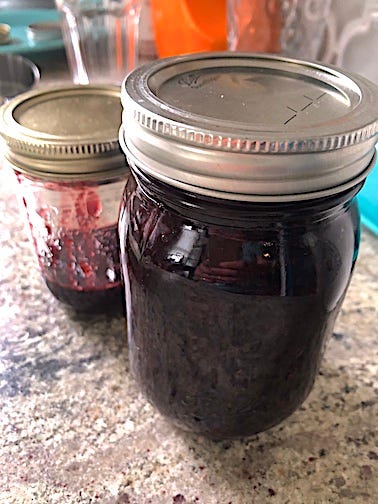Sand cherry - or Hansen's bush cherry - jam
Sugar-free, pectin-free, chunky like a chutney, and oh-so-good.
By Lisa Brunette
At our recent Sustainable Backyard Tour, the sand cherry bushes caused quite a stir.
The fruit hadn’t yet ripened to red as you see in the photo above, so they looked like green olives, and the lanceolate leaves also help give that impression. Yes, I just flexed a botany term on you: lanceolate is used to describe slender, narrow leaves like those above, sort of like lances. So folks kept asking if they were olives, but of course, the olive is a Mediterranean tree and wouldn’t grow well in our humid subtropical climate.
They’re sand cherries, a North American native plant.
We actually grow a “nativar” (for native plant that’s been cultivated) called Hansen’s bush cherry. We bought it from Missouri’s own Stark Bros. nursery, but sadly, they no longer offer it.
Which makes the fact that I almost ripped out both our bushes last fall even more unbelievable. Up until this year, the sand cherries hadn’t produced much; just a few astringent berries that were more work than they were worth trying to use, since you can’t eat them off the tree. They take up some real estate, with their weeping habits and tendency to sucker. So they almost got the axe.
But I’m a sentimental sort, and I decided to hold off, giving them another chance.
Maybe they knew they needed to make a case for themselves, because this year they did exactly that. We’ve harvested enough plump, juicy berries for three batches of sand cherry jam, and woo-wee, is it delicious!
The sand cherry bushes now make for efficient use of space, considering what they give both us and the wildlife. They’re also very easy to grow. We do not apply any synthetic fertilizers to our crops, and that includes our fruit bearers. They get compost tea and wood-chip mulch, and some extra watering at the beginning of their life cycle, especially if we’re having a drought. But that’s it.
Now because sand cherries are naturally astringent, I was a little worried they wouldn’t preserve well without copious amounts of sugar. They might look delicious, but if you try to eat some straight off the tree, your mouth will pucker up like you’ve bitten into a lemon. Some people say if you let them ripen until black they’re good, though we haven’t found that to be the case.
But I like to experiment, and if I can get away with a sugar-free version, that’s what I’m gonna do. And you know what? It totally worked. Anthony and I both agreed that the sugar-free jams taste better—deeper, more flavorful, and less cloying—than the ones I made with sugar. Admittedly, I don’t have much of a sweet tooth, but he definitely does, and if it can impress his palate, it’s sweet enough.

For our paid subscribers, here’s the recipe I developed for a chunky, chutney-style jam.






